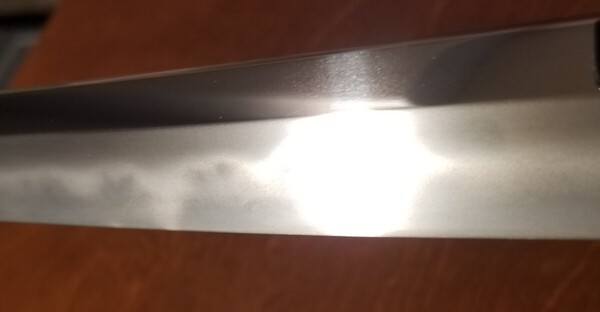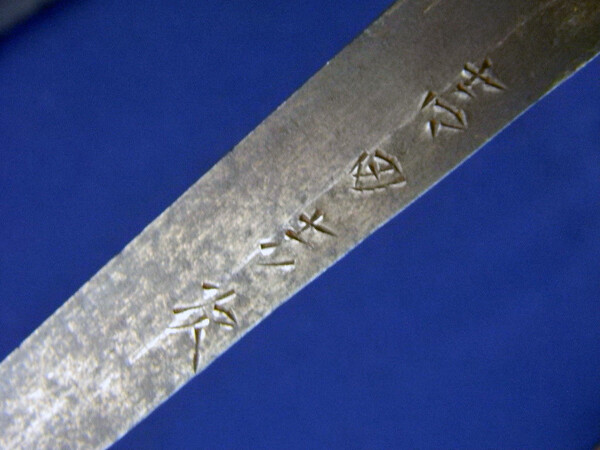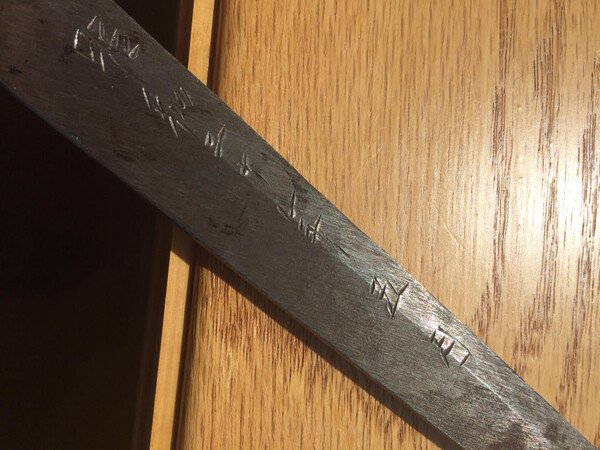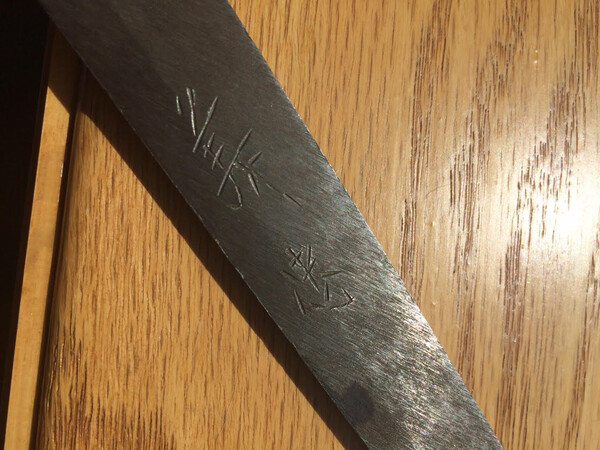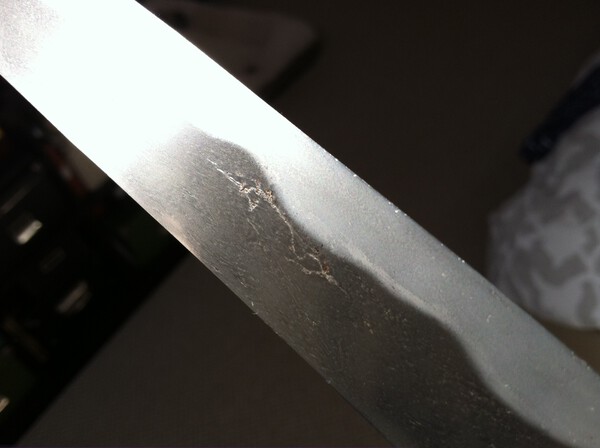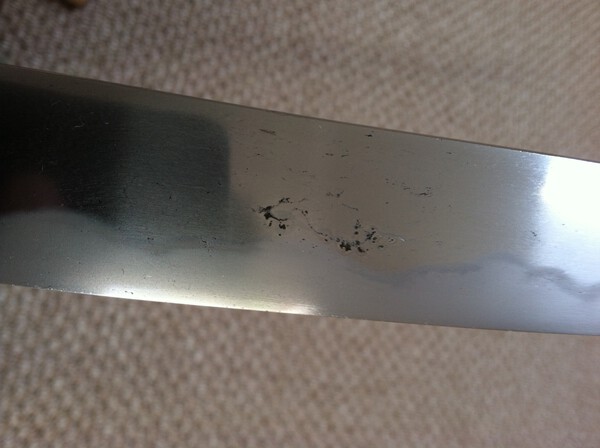-
Posts
215 -
Joined
-
Last visited
-
Days Won
1
Content Type
Profiles
Forums
Events
Store
Downloads
Gallery
Everything posted by JH Lee
-
Like with most other things with Japanese swords, I'm sure there's no absolute rule here. I'm just repeating what was told to me by craftsmen. And students at my dojo do shim their saya, as you pointed out, when wear and tear accumulate on their training iaito. But we also always shim only the ha/mune sides around the koiguchi.
-
A properly made saya should only hold the habaki by the ha and mune sides. Maybe it wouldn't wear as quickly as we think.
-
My most sincere condolences, Robert. Our thoughts are with you. He's in Kitty Heaven (yes, I actually believe our pets go to heaven), and he will have a great time making friends with my Linus, who was quite the social butterfly.
-
In my personal collection is a wakizashi by Iga-no-Kami Kinmichi (2nd gen; Wazamono). Pics attached just because. My question isn't about this smith/wakizashi, but rather about the smith "Izumi kami Rai Kinmichi." Is the latter a later generation smith from the same Kinmichi lineage?
-
The way the bids climb so consistently and rapidly on his auctions always seemed a bit suspect to me. That said, I have gotten very nice pieces from him in the past at reasonable prices.
-
Thank you so much, Chris. Any ideas what type of steel smiths like Kunifusa might have used? Considering he also used traditional tamahagane, I would guess he would have been thoughtful in what he chose rather than just picking up some random thing off of his shop floor. I know that koa-isshin mantetsu were used with non-traditional steel but also forge-welded a softer core inside harder outer steel. I wonder if similar techniques might ever have been employed by other smiths using modern "machine steel." Fascinating stuff. Any information would be greatly appreciated!! Thanks again, everyone.
-
What would be the proper classification for such a water quenched blade? Gendaito? Showato? Showa gendaito? Also, any information on the type of "machine steel" likely to have been used? Thanks, everyone.
-
I have a gendai katana that is currently in the process of being restored. The polisher sent me this in-progress photo earlier today. Initially, I was extremely disappointed because I thought the hamon was running off of the edge, which would constitute a fatal flaw. Then again, the polisher informed me that there is nie/nioi in that area and that it was fine. So, I started to look into nie/nioi deki hamon and its structural properties... which basically tells me that what I am seeing in this photo is probably not a fatal flaw after all. Could someone with more knowledge and experience help me to better understand how I should interpret what I am seeing? Thank you!
-
Vince, the Ohmura website's English translation is difficult to comprehend..... As private Zōhei-tō's swordsmith, of "Yoshimasa, Kaneshige, Yoshitada, and Kanemasa"of Kyōshinsha limited Co. and "Yorimasa"of Hattori Guntō Seizō Inc etc, is checked. They are a commission swordsmith or a swordsmith. Also from this thing, it is hard to consider this Zohei-to to be a blade of an army sword steel one-sheet forging. However, the meaning of description of the account of recollection of Major Bito as the party concerned is heavy. In short, what is the conclusion one should draw about such blades that are signed "Yoshitada" or "Yorimasa" etc.??? They are blades made as custom commission by individual smiths...? and are in whole another category from other lower-quality mass-produced showato...? That last sentence is completely confusing.....
-
For what it's worth, the link to the "reading" mei characters has been really helpful and also empowering, enabling me to look up various resources based on the oshigata I come across. I'm improving at what feels like a glacial pace, but slowly is better than not at all, I think. Anyway, the fact that there is no arsenal stamp on the nakago adds to the mystery for me of this particular "Yoshitada." But then, the most logical explanation might be that it was just an oversight. I'm sure that in mid-1945, there were more pressing concerns on people's minds than making sure that a mass produced officer's sword's tang was properly stamped. Just my own guess though, because I'm inclined to defer to more experienced collectors' view that this is probably a showato. But "chippy" mei is definitely confusing. More recently, I've been able to read this one as "Yoshida (__)-tsugu." I thought it said "Masatsugu" but there was no information that I've been able to find on such a person. Then, I was able to find a showa smith who signed "Yoshida Yoshitsugu" (1926~1989), then inferred that what I thought was "masa-" was a second "yoshi-" that looked different from the first one. Of course, I could be totally wrong (wouldn't be the first time).
-
Thank you, Grey. There is no arsenal stamp, but there is no star stamp either.... Would it be a mistake to infer that this could be a gendaito and not a non-traditional showato? According to "Index of Japanese Swordsmiths" by Markus Sesko, there was only one Yoshitada (Kinoshita) active during this period. But this signature matches none of the other Yoshitada mei I've found.... e.g. http://www.ryujinswords.com/yoshitada.htm http://www.hizento.net/index.php?page=sell-S8
-
Now I'm not sure that the first chacter is "yoshi"... but definitely I think Joe is right that the second character is "tada"... thank you Joe.
-
I've been trying to make sense of this, but am stuck after what appears to me to be "yoshi"... Help?
-
Please see pictures. Any help with identification would be appreciated. Am told it's a wartime blade. I can't read Japanese, but the signature just feels somehow... slightly odd to me. Thanks in advance everyone!
-
I don't know. Like I said, I received it in this condition when I bought it.
-
I have a lovely wakizashi in good polish that came to me with a spot of rust. It looks like the rust initially developed in a spot of kitae-ware/grain opening. My concern is that I do not want the rust to spread visibly or deeper into the steel. I keep the blade in shirasaya, in a dry environment, well-oiled (but not overly so, of course; just a thin layer). What is the best solution for this kind of problem with rust? Is there a danger that the rust will spread or get deeper?
-
If it's not too much trouble, could you please elaborate on what you see, John?
-

Tamahagane Analysis + Question
JH Lee replied to JH Lee's topic in General Nihonto Related Discussion
Thank you all. Yes, it is quite bizarre. I have asked him to sample other parts(?) of my ores. There is also another, much larger ore that was sent directly from a smith's forge in Seki, and he will be analyzing that sample as well. I'll update with any interesting information. By the way, any suggestions about where on an antique nihonto would be most useful to take a sample for metallurgical analysis, without diminishing the value/risking its overall integrity? Wouldn't there be a lot of variation depending on the portion of the blade? My scientist friend only needs to take about 1 cubic millimeter, but my guess is that a sample from the nakago (I was thinking from around the mekugi-ana, to be on the safe side) would yield different results than from say, around the ha-machi. If the construction involves complex lamination, then there would be even more variables. In case anyone is wondering, the samples will be taken by another researcher from the archaeology/anthropology dept of the university, with very sensitive/fine tools... (just in case anyone was horrified, imagining someone going after a nihonto with a chisel and hammer~ lol ). -

Tamahagane Analysis + Question
JH Lee replied to JH Lee's topic in General Nihonto Related Discussion
Any information would be very much appreciated. Thank you in advance. -

Tamahagane Analysis + Question
JH Lee replied to JH Lee's topic in General Nihonto Related Discussion
From the shop inside, on the second floor, right before the entrance to the area where swords/fittings were displayed (which were all gorgeous). -
A scientist that I know is analyzing samples of tamahagane that I picked up during my recent trip to Japan (from the NBTHK in Tokyo). To his (and my) confusion and surprise, he found ~20% copper (Cu) alloyed with the iron! Since he didn't find any copper minerals in the iron sand (satetsu) sample, the only guess we have is that somehow some copper-bearing mineral was accidentally or purposefully mixed in the tatara during the smelting. Could anyone please comment on this and shed some light? Thank you!
-
Thank you, everyone, as always, for the enlightening information. Jussi, I absolutely love that video link. I was especially delighted to see the use of jumonji yari-- as I've always wondered how it was used. Very, very cool. I wonder if the jumonji design was ever adapted as a shorter "kago" yari.
-
Specifically, I am curious about how short were the shortest naginata (the pole), and whether they saw any indoor use historically. Or would indoor spaces (in traditional Japanese castle architecture) have made them unusable or pointless (maybe since not enough room to use them to full effect). Also, were any naginata-naoshi wakizashi ever re-mounted as naginata? Or would that have been impossible/not functional since the nakago would now be too short to be mounted in a pole?




